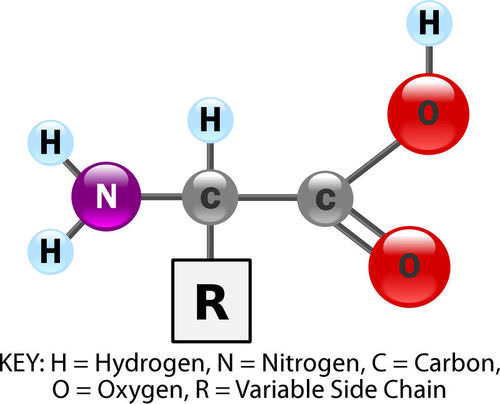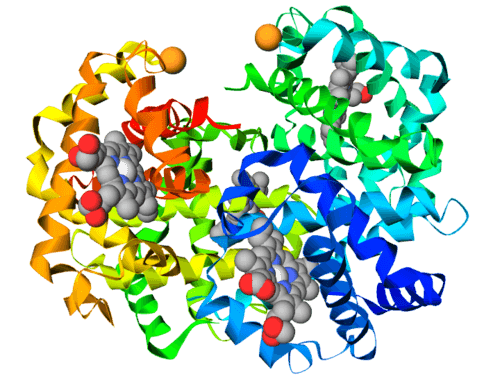2.5 蛋白质 - 高级
章节大纲
-
You may have been told proteins are good for you. Do these look good to you?
::你可能被告知蛋白质对你有好处 这些看起来好看吗?Proteins as food ? To you, these may not look appetizing (or they might), but they do provide a nice supply of amino acids , the building blocks of proteins. Proteins have many important roles, from transporting, signaling, receiving, and catalyzing to storing, defending, and allowing for movement . Where do you get the amino acids needed so your can make their own proteins? If you cannot make the amino acids yourself - and some of them you cannot make - then you must eat them.
::蛋白质是食物吗?对你们来说,蛋白质可能看起来不尽如人意(或可能),但它们确实提供了大量氨基酸,即蛋白质的构件。蛋白质有许多重要作用,从运输、信号、接收、催化到储存、防御和允许移动。你从哪里得到所需的氨基酸,以便自己制造蛋白质?如果你不能自己制造氨基酸,而其中一些不能制造,那么你就必须吃。Proteins
::蛋白质Proteins are that contain carbon, hydrogen, oxygen, nitrogen, and, in some cases, sulfur. These compounds may have many essential functions within the cell (see below). Proteins are made of smaller units called amino acids . There are 20 different common amino acids needed to make proteins. All amino acids have the same basic structure, which is shown in the Figure . Only the side chain (labeled R in the figure) differs from one amino acid to another. These side chains can vary in size from just one hydrogen atom in glycine to a large heterocyclic group in tryptophan. The variable side chain gives each amino acid unique properties. The side chains can also characterize the amino acid as (1) nonpolar or hydrophobic , (2) neutral (uncharged) but polar, (3) acidic, with a net negative charge, and (4) basic, with a net positive charge at neutral pH.
::蛋白质中含有碳、氢、氧、氧、氮,有时还含有硫磺。这些化合物在细胞内可能有许多基本功能(见下文)。蛋白质由称为氨基酸的较小单位组成。有20种不同的常见氨基酸,以制造蛋白质。所有氨基酸都有相同的基本结构,如图所示。只有侧链(图中标注为R)与侧链(图中标注为R)不同。这些侧链的大小可能从甘油中的氢原子到锥虫中的大型热循环组不等。不同的侧链提供了每一种氨基酸独有的特性。侧链还可以将氨基酸描述为1)非极地或防水的,(2)中性(未加注),但极地,(3)酸性,净负电荷和(4)基本,中性pH有净正电荷。
Proteins can differ from one another in the number and sequence (order) of amino acids. It is because of the side chains of the amino acids that proteins with different amino acid sequences have different shapes and different chemical properties. Small proteins can contain just a few hundred amino acids. Yeast proteins average 466 amino acids. The largest known proteins are the titins, found in muscle, which are composed from over 27,000 amino acids.
::蛋白质在氨基酸的数量和序列(顺序)方面可能互不相同,这是因为氨基酸的副链,不同氨基酸序列的蛋白有不同的形状和化学特性,小蛋白只含有几百种氨基酸,动物蛋白平均466种氨基酸,已知最大的蛋白是肌肉中发现的乳油,由27 000多种氨基酸组成。General Structure of Amino Acids. This model shows the general structure of all amino acids. Only the side chain, R, varies from one amino acid to another. For example, in the amino acid glycine, the side chain is simply hydrogen (H). In glutamic acid, in contrast, the side chain is CH2CH2COOH. Variable side chains give amino acids different chemical properties. The order of amino acids, together with the properties of the amino acids, determines the shape of the protein, and the shape of the protein determines the function of the protein. KEY: H = hydrogen, N = nitrogen, C = carbon, O = oxygen, R = variable side chain Protein Structure
::蛋白结构Amino acids can bond together through peptide bonds to form short chains called peptides or longer chains called polypeptides ( Figure ). A peptide bond is a covalent bond formed from a condensation reaction between two molecules, causing the release of a molecule of . This bond usually forms between two amino acids, hence forming a peptide or polypeptide. Peptide bonds between amino acids are formed during the process of .
::氨酸可以通过浸泡酸债券联结成短链,称为peptide(Peptide)或称为popptides(Pipptide)的长链(Figure ) 。 浸泡酸债券是两个分子之间凝聚反应形成的共价债券,造成分子释放。 这种债券通常由两个氨基酸组成,从而形成peptide或聚pptide。 氨基酸之间形成peptide债券是在氨基酸过程过程中形成的。Polypeptides may have as few as 40 amino acids or as many as several thousand. A protein consists of one or more polypeptide chains. The sequence of amino acids in a protein's polypeptide chain(s) determines the overall structure and chemical properties of the protein.
::一种蛋白质由一种或多种聚虫化链组成。蛋白质的聚虫化物链中的氨基酸序列决定了蛋白质的整体结构和化学特性。Polypeptide. This polypeptide is a chain made up of many linked amino acids. The amino acid sequence is the primary structure of a protein. As explained in the Figure , a protein may have up to four levels of structure, from primary to quaternary. The complex structure of a protein allows it to carry out its biological functions.
::氨基酸序列是蛋白质的主要结构。正如图中解释的那样,蛋白质可能具有从初级到四角的四级结构。蛋白质的复杂结构使得蛋白质能够发挥其生物功能。Secondary structure refers to local sub-structures generated from the primary structure, usually involving alpha helix and beta pleated sheet structures. These secondary structures form through hydrogen bonding between amino acids.
::二级结构是指由初级结构产生的当地次级结构,通常涉及甲型螺旋和乙型副架状结构。这些二级结构通过氨基酸之间的氢结结形成。Tertiary structure refers to the three-dimensional structure of a single polypeptide. The alpha-helices and beta-sheets are folded into a compact globule structure. Stability is maintained through hydrogen bonds , disulfide bonds, and other interactions.
::第三层结构是指单聚极化物的三维结构。 α- heilices 和 beta shells 被折叠成紧凑的球状结构。 稳定通过氢债券、脱硫债券和其他相互作用得以维持。Quaternary structure is a larger assembly of several polypeptide chains, now referred to as subunits of the protein. The quaternary structure is stabilized by the same interactions as the tertiary structure. Complexes of two or more polypeptides are called multimers. Specifically, a dimer contains two subunits, a trimer contains three subunits, and a tetramer contains four subunits.
::四极结构是一个由多个多孔化物链组成的较大组合体,现称为蛋白质的子单位。四角结构由与第三层结构相同的相互作用稳定下来。两个或两个以上的多孔化物的复合体称为多孔化物。具体地说,二极体包含两个子单位,三极体包含三个子单位,四极体包含四个子单位。Protein Structure. Primary protein structure is the sequence of amino acids in a single polypeptide. Secondary protein structure refers to internal shapes, such as alpha helices and beta pleated sheets, that a single polypeptide takes on due to bonds between atoms in different parts of the polypeptide. Tertiary protein structure is the overall three-dimensional shape of a protein consisting of one polypeptide. Quaternary protein structure is the shape of a protein consisting of two or more polypeptides. For a brief animation of protein structure, see www.stolaf.edu/people/giannini/flashanimat/proteins/protein%20structure.swf. The atomic mass of proteins is measured in kilodaltons (kDa). One dalton (Da) is approximately equal to the mass of one proton or one neutron, so a carbon atom has a mass of approximately 12 Da. The molecular weights of amino acids range from 75 Da for glycine to 204 for tryptophan. Human proteins may have molecular weights ranging from a low of about 3.7 kDA to titin, the largest known human protein with 34,350 amino acids and a molecular weight of approximately 3,816.2 kDa.
::蛋白质原子质量以千达吨(kDa)测量,一个达吨(Da)大约等于一个质子或一个中子的质量,因此碳原子的重量约为12达。氨基酸的分子重量从75达到204纳不等。人类蛋白的分子重量从大约3.7kDA到奶油不等,乳油是已知最大的人类蛋白,有34,350个氨基酸,分子重量约为3,816.2kDa。Functions of Proteins
::蛋白质函数Proteins are an essential part of all organisms . They play many roles in living things. Certain proteins provide a scaffolding that maintains the shape of cells (structural proteins). Proteins also make up the majority of muscle tissues . Many proteins are that speed up chemical reactions in cells. Enzymes interact with the substrates (reactants) of a , helping the reaction proceed at a much faster rate. Other proteins are antibodies that protect you from . Antibodies bind to foreign substances in the body and target them for destruction. Still other proteins help carry messages or materials in and out of cells (transport proteins) or around the body. For example, the protein hemoglobin (see the Figure ) bonds with oxygen and carries it from the lungs to cells throughout the body.
::蛋白质是所有有机体的一个基本部分。 蛋白质在生物中扮演着许多角色。 某些蛋白质提供了维持细胞形状的脚架( 结构蛋白质) 。 蛋白质也构成肌肉组织的大多数。 许多蛋白质是加速细胞中的化学反应。 酶与一个细胞的基质( 反应剂) 互动, 帮助反应速度更快。 其他蛋白质是抗体, 保护你免受感染。 抗体与体内的外来物质结合, 并且将它们作为毁灭目标。 还有一些蛋白质有助于在细胞( 运输蛋白质) 或身体周围传递信息或材料。 例如, 蛋白质血红素( 见图) 与氧的联结, 并携带它从肺到全身的细胞。Hemoglobin Molecule. This model represents the protein hemoglobin. The red parts of the molecule contain iron. The iron binds with oxygen molecules. One of the most important traits of proteins, allowing them to carry out these functions, is their ability to bond with other molecules. They can bond with other molecules very specifically and tightly. This ability, in turn, is due to the complex and highly specific structure of protein molecules. The structure-function relationship of proteins is an important principle of biology . A slight difference in the structure of a protein can lead to a difference in the function of that protein, and this can have devastating effects on the cell or organism.
::蛋白质的最重要特征之一是能够与其他分子结合。它们可以非常具体和紧密地与其他分子结合。反过来,这种能力又由于蛋白质分子的复杂和高度特殊结构而产生。蛋白质的结构功能关系是生物学的一项重要原理。蛋白质结构的微小差异可能导致蛋白质功能的差别,这可能会对细胞或生物体产生破坏性影响。Proteins and Diet
::蛋白质和饮食Proteins in the diet are necessary for life. Dietary proteins are broken down into their component amino acids when food is digested. Cells can then use the components to build new proteins. Humans are able to synthesize all but nine of the twenty common amino acids. These nine amino acids, called essential amino acids , must be consumed in foods. Like dietary and , dietary proteins can also be broken down to provide cells with energy . The amino acids regarded as essential for humans are phenylalanine, valine, threonine, tryptophan, isoleucine, methionine, leucine, lysine, and histidine. Additionally, cysteine, tyrosine, and arginine are required by infants and growing children.
::饮食中的蛋白质是生命所必需的。饮食中的蛋白质在食物消化时被分解成其成分的氨基酸。细胞可以使用成分来制造新的蛋白质。人类可以合成20种常见氨基酸中除9种外的所有物质。这9种氨基酸,称为氨基酸,必须用在食物中。与饮食和饮食蛋白一样,饮食蛋白也可以分解为细胞提供能量。被认为对人类至关重要的氨基酸是苯丙胺、valine、血清、Treptophan、异丙酮、甲状腺素、甲状腺素、、素、素、素、赖氨和丁。此外,婴儿和成长中的孩子也需要细胞、抗抑郁素和。In addition, certain amino acids (arginine, cysteine, glycine, glutamine, histidine, proline, serine, and tyrosine) are considered conditionally essential, meaning they are not normally required in the diet, but must be supplied to specific that do not synthesize them in adequate amounts. An example would be the disease phenylketonuria (PKU) . Individuals with PKU must keep their intake of phenylalanine extremely low to prevent mental retardation and other metabolic complications. However, they cannot synthesize tyrosine from phenylalanine, so tyrosine becomes essential in the diet of PKU patients. PKU can be easily detected with a simple blood test. All states in the US require a PKU screening test for all newborns as part of the newborn screening panel. These individuals are placed on a special diet as soon as the disease is detected, a diet that is extremely low in phenylalanine, particularly when the child is growing. The diet must be strictly followed. Those who continue the diet into have better physical and mental health. Maintaining the diet for life has become the standard recommended by most experts.
::此外,某些氨基酸(阿金宁、cysteine、glycine、夸大胺、丁丁、proline、serin、和tyrosine)被认为是有条件的必不可少的,这意味着饮食通常不要求它们,但必须供应给没有充分合成它们的特定物质,例如苯丙酮尿(PKU),PKU患者必须保持其苯丙拉尼摄入量极低,以防止智力迟钝和其他新陈代谢并发症。然而,他们不能合成苯丙胺的催泪素,因此,苯丙胺在PKU患者的饮食中变得必不可少。PKU很容易通过简单的血液测试检测得到。美国各州都需要对所有新生儿进行PKU检查,作为新生儿检查小组的一部分。这些人在疾病检测后立即接受特殊饮食,苯丙胺饮食极低,特别是在儿童成长时。必须严格遵循饮食。那些继续饮食以更健康为饮食的人,必须接受最高质量的专家的建议。Summary
::摘要-
Proteins are organic compounds that consist of carbon, hydrogen, oxygen, nitrogen, and, in some cases, sulfur.
::蛋白质是有机化合物,由碳、氢、氧、氮和在某些情况下硫组成。 -
Proteins are made up of repeating units called amino acids.
::蛋白质由称为氨基酸的重复体组成。 -
Proteins provide cells with energy, form tissues, speed up chemical reactions throughout the body, and perform many other cellular functions.
::蛋白质为细胞提供能量、组织形式、加快整个身体的化学反应,并履行许多其他细胞功能。
Review
::回顾-
What is a protein?
::什么是蛋白质? -
What determines the primary structure of a protein?
::是什么决定了蛋白质的主要结构? -
Describe the structural levels of proteins.
::描述蛋白质的结构水平。 -
State three functions of proteins, and explain how the functions depend on the ability of proteins to bind other molecules to them.
::蛋白质的三个国家功能,并解释这些功能如何取决于蛋白质将其他分子与蛋白质结合的能力。
-
Proteins are organic compounds that consist of carbon, hydrogen, oxygen, nitrogen, and, in some cases, sulfur.




